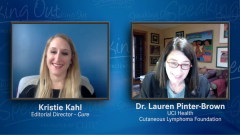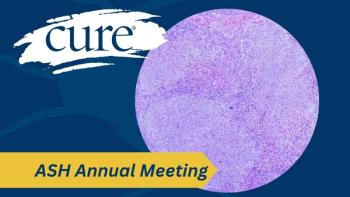
Treatment Options for Cutaneous T-Cell Lymphoma
Kristie L. Kahl: To start, can you talk about how cutaneous T-cell lymphoma is staged?
Dr. Steven M. Horwitz: So, cutaneous T-cell lymphoma, sort of by the name is a lymphoma, a cancer of certain kinds of white blood cells, T cells in this case. In most patients, it starts in the skin, and in many, it's only in the skin. So, we do give it a numerical stage based on how much is in the skin. The critical features in that are whether there's a lot of skin involved or just a little bit, and we quantify how much skin is involved based on percentage of skin involvement.
So, your palm and four-fingers is about 1% of your body surface area, whether the lesions are relatively flat, smooth or a little bit rough, which we call patches and plaques, or whether they're lumpy or what we call tumors, and whether there's any significant disease inside the body.
When you put all that together, we give it a numerical stage, which is sort of descriptive. But I think that tells the doctor whether the treatment can be skin only, or needs to be skin plus medicines that go inside the body, and what kind of treatments are potent enough or for the amount of disease you have.
Kristie L. Kahl: Can you discuss the difference between what's considered aggressive disease and what's indolent disease?
Dr. Steven M. Horwitz: For lymphomas, we talk about aggressive and indolent. And what that really means to the doctor is the rate of growth. Lymphomas that tend to grow slowly, we call indolent. It doesn't mean they're not dangerous lymphomas. When they tend to grow quickly, we call aggressive. It doesn't necessarily mean they're dangerous, but different treatments and different treatment strategies lend themselves to that.
For most people with cutaneous T-cell lymphoma, the disease grows at a relatively slow rate. And that means that it grows over many months or years, not days to a month or two. And we would call that an indolent growth rate. But people with more advanced disease, tumors or lumps, or significant disease in the body, are at more risk, or there's more danger from the disease. We can think about those lymphomas as behaving not as a necessarily an aggressive growth rate, but more like aggressive in terms of the risk to the person. And then sometimes the treatments we give need to be a little more intense, or more reliably active to get good control of that disease relatively quickly. Whereas with a very slow growing disease, you might lean towards very mild treatments that have as little side effect as possible, knowing that you have a lot of time to slowly get the disease under control.
Kristie L. Kahl: And similar to that, how does staging play a role in treatment options?
Dr. Steven M. Horwitz: The main thing about staging for skin lymphomas is if their disease is inside the body or not. If there's disease in the blood or lymph nodes, then the way to address the disease has to be with medicines. It could be chemotherapy, it could be immune system therapy, but medicines that treat the inside of the body, as opposed to the majority of people with skin lymphomas where the treating will be largely directed at the skin – light treatment, topical treatments, things you put on the skin – but no real treatment inside the body. And I think in terms of stage and treatment, that's really the most critical distinction.
Kristie L. Kahl: How do physicians determine when to change treatment for a patient?
Dr. Steven M. Horwitz: Yeah, this is something that involves a lot of discussion and back and forth and what we call joint decision making, meaning My goal as a physician is that you are well and healthy and live your full life while I keep the disease under control and minimize the risk to you. And I think most patients are aligned with that. But what happens when the disease is on the skin is there's also visible disease, there's symptoms from the disease, and sometimes the most potent therapies that get the skin looking better and feeling better, may limit or take away options for the future or may cause more risk of side effects and then it's sort of a balance, meaning I want the safest, mildest therapy to keep you well. Many patients also want to look better and feel better as soon as possible which is totally really valid. And then how do we negotiate that in terms of what treatments makes sense to try? When do we say this is not working well enough, we need to add or modify, or when is this clearly the safest treatment? And we need to give it a little longer to see maybe what slow benefit for the long term gain or the overall safety? And it's a lot of back and forth and discussion with that.
Kristie L. Kahl: If a disease does progress, what are the best treatment options that we have available right now?
Dr. Steven M. Horwitz: It's always hard to make a general statement of what are the best because, again, there are those different dynamics in terms of what our goals of therapy are, the best treatment. Answering in a simplistic way is the one that gets your disease better and doesn't cause any side effects. Or, because we keep these (patients on these) treatments for a long period of time, (choosing a treatment that) doesn't cause any cumulative side effects, to where if it's working, we can keep going. We're more worried about treatments that cause accumulation of side effects or strong immunosuppression, things that could weaken the immune system, put people at risk of infection. So really, the best treatments are those that are effective, but also those that don't accumulate side effects or aren't too harsh on the immune system.
Kristie L. Kahl: How does advanced systemic therapy play a role in treatment?
Dr. Steven M. Horwitz: We add systemic therapy either when there's disease inside the body or when skin-directed therapies are not adequately controlling it. So that might be adding a mild therapy like a retinoid, there's a medicine called (Mekinist [trametinib]) that we add frequently, which might boost light therapy, make light treatment or photo therapy to the skin work better, might add a little bit of mild systemic therapy. And there's other medicines that can do the same thing.
When the disease is really progressing at a faster rate inside the body, then we really need more potent treatments that address that. In the past that was primarily chemotherapy. And chemotherapy was often a bad long-term deal for people with cutaneous lymphomas, because while they can work at controlling the lymphoma, there is some accumulation of side effects. And it's very hard to safely be on those treatments for the years and years of life that we're hoping people achieve.
So there's drugs called histone deacetylase inhibitors … They can work in different ways to control the lymphoma without really suppressing the immune system. More and more, we're having immune-based therapies and in some ways, harnessing or adding to the normal immune system to fight cancer overall, but including in cutaneous T-cell lymphoma. That is often a better, safer long-term solution.
There's also antibodies, a drug called mogamulizumab, or Poteligeo, which treats by targeting the immune system to fight the lymphoma cells. It’s particularly good in Sezary syndrome. There's some other new treatments being developed along the same lines.
And then other treatments that unlock or unleash the immune system, things that we call T cells, checkpoint inhibitors, treatments like that. There's a drug called brentuximab vedotin, which uses an antibody to target chemotherapy, rather than to the whole body, specifically just to the cancer cells, or mostly to the cancer cells.
So there are a lot of advances in those treatments that, while potent enough to get systemic disease under control, don't really have those significant or strong, limiting side effects that you can't be on them very long. Other things that you'll see in other cancers that are just starting to be understood in cutaneous T-cell lymphoma are some strategies that teach other arms of the immune system, something called macrophages, or CD47. That's a pathway that you can block to try to target the immune system to fight the lymphoma, and then cellular therapy trying to teach your own cells or cells from another person to sort of re-engineer them, what we call chimeric antigen receptor (CAR)-T cells or other forms of genetically engineered cells to use those cells to fight the lymphoma. Those are in very early phase clinical trials. But I think a lot of us see that, as we go forward, those may be the more significant breakthroughs in the future.
Kristie L. Kahl: How does auto stem cell transplantation come into play for a treatment option?
Dr. Steven M. Horwitz: So autologous stem cell transplantation is really a way of giving very intensive, very high doses of chemotherapy to try to treat the residual lymphoma, and sometimes leukemia. The side effect of that intensive therapy is that the normal bone marrow, the normal stem cells, would be damaged severely. So, you harvest the autologous cells, give the strong chemotherapy, then give those cells back so you can have normal blood counts. What has been learned in past decades is that autologous stem cell transplantation or strong chemotherapy in general can have short-term benefit in controlling cutaneous T-cell lymphomas, but there's almost never long-term benefit. As opposed to some other types of aggressive lymphoma, where autologous stem cell transplant can potentially cure people or get rid of their disease permanently, for cutaneous T-cell lymphoma, it's usually a short-term benefit, and the disease usually comes back. We almost never use autologous transplant for cutaneous T-cell lymphoma.
On the other hand, allogeneic stem cell transplant, where you get another person's immune system, that immune system can recognize your lymphoma and get rid of your lymphoma. This is a potentially curative strategy, meaning there are people who've gotten that with otherwise quite severe cutaneous T-cell lymphoma, who've had their disease go away and never come back. However, it's a very high-risk strategy. There's a lot of life-threatening risks of transplant where it could shorten your life. There's a fairly high rate of the lymphoma coming back anyway. So, while it's something we look for as maybe not last treatment, but maybe a very late line treatment, when we don't have other ways of controlling the disease, it's a very high risk, high reward strategy that is sometimes used. I think our hope is with some of these better immune therapies as we get more therapeutic advances, that the need for allogeneic stem cell transplant will be less and less.






